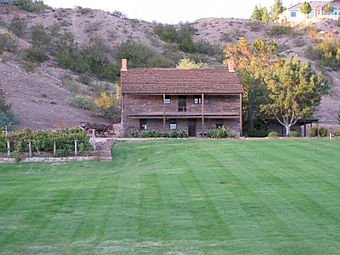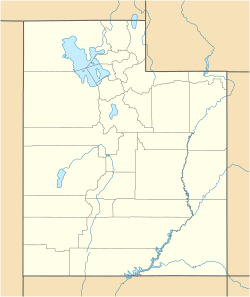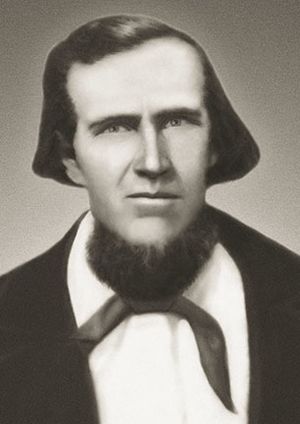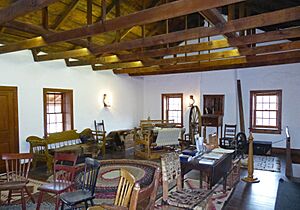Jacob Hamblin House facts for kids
Quick facts for kids |
|
|
Jacob Hamblin House
|
|
 |
|
| Location | 3400 Hamblin Drive Santa Clara, Utah United States |
|---|---|
| Built | 1863 |
| NRHP reference No. | 71000860 |
| Added to NRHP | March 11, 1971 |
The Jacob Hamblin House is a special old home and museum located in Santa Clara, Utah. It was once the home of Jacob Hamblin, a brave Mormon pioneer and missionary. He helped start the town of Santa Clara in 1854. Missionaries built this house for Jacob Hamblin in 1863 after a big flood destroyed his first home and much of the town.
In 1959, the house was given to Utah State Parks and Recreation. They fixed it up and opened it as a historic house museum. Later, in 1974, The Church of Jesus Christ of Latter-day Saints (often called the LDS Church) took over the property. Since then, missionaries from the church have offered free tours of the home.
Contents
History of the Jacob Hamblin House
Who Was Jacob Hamblin?
Jacob Hamblin was born in 1819 in Ohio. In 1842, he learned about The Church of Jesus Christ of Latter-day Saints and joined it. Church leaders quickly saw his skills and invited him to Nauvoo, Illinois.
In 1844, the church's leader, Joseph Smith, was killed. This led to a time when several people claimed they should lead the church. Jacob Hamblin supported Brigham Young as the new leader. He then traveled west along the Mormon Trail to help the church build new communities. Jacob Hamblin's first wife left him when he moved west. He married Rachel Judd in 1848 and later married several other women.
Hamblin first settled in Tooele, Utah Territory. There, he became friends with many local Native Americans. Brigham Young noticed his good relationships. He asked Hamblin to become a missionary to the Paiute people. Hamblin moved to the southern part of Utah and founded the town of Santa Clara in 1854.
Building the Hamblin Home
In 1862, a big flood covered the entire town of Santa Clara. This flood forced everyone to build new homes. A group of missionaries came to Santa Clara in 1863. Their job was to build a new house for Jacob Hamblin's family. The new Jacob Hamblin home was finished later that year.
Workers used sandstone from nearby hills to build the house. Stone masons from Cedar City helped put the stones together. The house has two stories and was built on a hillside. This design allowed people to enter the second floor from the top of the hill. There is a porch on both the first and second floors across the front of the house. The house had identical rooms on opposite sides. These rooms were built to make space for Hamblin's two wives. Each room had its own fireplace and a staircase to the second floor.
Jacob Hamblin's wife Rachel passed away in 1865. He then married Louisa Bonelli, who was from Switzerland. In 1871, Hamblin was asked to serve in the Kanab area. He then rented his house to a person named Mr. Bauman.
The House Through the Years
The Jacob Hamblin House later became the property of the Samuel Knight family. In 1943, Dudley J. Hamblin, who was Jacob Hamblin's son, bought the home from the Knights. In 1959, Clara Harmon, Dudley J. Hamblin's daughter, and other family members gave the home to Utah State Parks and Recreation.
At that time, the house was in very poor condition. After a lot of research, the state began to restore the building. The newly restored home was officially opened to the public on August 22, 1964. This event was part of a large Hamblin family reunion. While owned by the state, the home was part of Dixie State Park.
In 1974, the LDS Church and the Utah state government made a trade. The state gave the Jacob Hamblin House (and the nearby Brigham Young Winter Home and Office) to the church. In return, the church gave the state the historic Brigham Young Forest Farmhouse in Salt Lake City. The church then began to operate the two homes in southern Utah as historic sites. The state moved the Forest Farmhouse to Pioneer Trail State Park (now This Is the Place Heritage Park).
The Jacob Hamblin House first opened under church control in April 1975. However, it closed that August for more restoration work and repairs. After being fixed up, church leader L. Tom Perry dedicated the home on May 29, 1976.
See also





